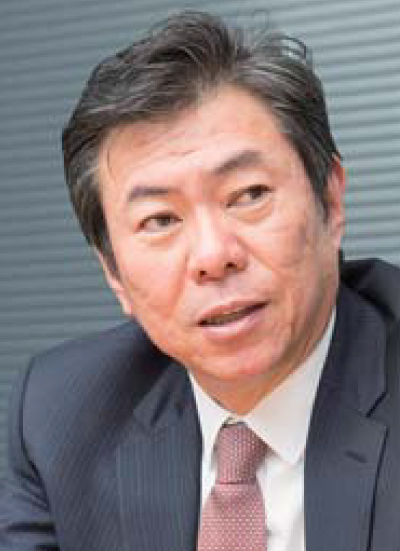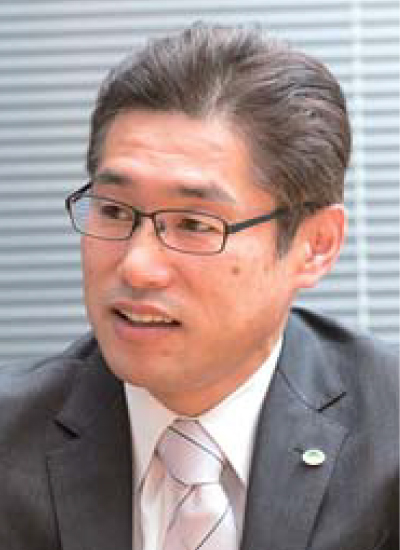Era in which Technology Drives Real Estate Services
 Toshiro Sato
Toshiro Sato
Executive Officer, Regional Director, Head of Japan Corporate Development, Jones Lang LaSalle K.K.
Akatsu:Having agreed to a partnership with Jones Lang LaSalle (JLL), a company that has built up know-how in the real estate industry, Hitachi is working to develop solutions for improving real estate services aimed at customers in the Asia-Pacific (APAC) region. At the urban solutions business field where I work, we want to turn this into an opportunity to expand our business in the real estate sector. Please tell us about your company's view of the background leading up to this partnership, and about your expectations with respect to Hitachi.
Sato:As a provider of real estate services that operates globally, JLL supplies a diverse range of real estate services to business operators and real estate investors around the world. While this industry has not always made full use of technology in the past, people have begun to take an interest over the last few years in property technology (proptech).
Recognizing this global trend, we chose to enter into a business partnership with Hitachi, a company with the latest technology and know-how, so that we could speed up service delivery and improve the quality of real estate services, and also provide next-generation services that go beyond the limits of real estate.
Akatsu:In terms of solution development, this started with solutions for optimizing office use. JLL, Hitachi, Ltd., and Hitachi Asia Ltd. embarked on a demonstration project in December 2016 that involved installing sensors in office spaces at the headquarters building of Hitachi Asia in Singapore to collect data on the use of desks, meeting rooms, and other spaces, and using artificial intelligence (AI) to analyze office use optimization.
Sato:That was the first stage of the demonstration project, which we called PoC1. Although we had previously built up know-how in making the most effective use of offices based on data analysis and supplied services, data collection relied on human input and involved periodically sending research staff to company offices to survey how meeting rooms, desks, and so on are being used. The demonstration project was a revelation to us because it could do automatically what had previously been done manually. When we saw the data that had been collated, we also realized that it could be put to all sorts of different uses.
Akatsu:The demonstration project provided visualizations of how offices were being used. Based on the data obtained, we developed a solution that offered efficient ways of using an office. We are working toward launching actual services from FY2018.
Genuine Work Style Reform by Making Workplaces More Advanced
 Masayuki Akatsu
Masayuki Akatsu
Department Manager, Service Development 1 Department, Total Building Optimization Division, Society 5.0 Promotion and Urban Solution Development Division, Social Innovation Business Division, Hitachi, Ltd.
Akatsu:We have also started working toward the next step, which looks at how we can develop solutions that offer ways of creating high-productivity workplaces that are easy to work in by using wearable name-tag sensors to measure and analyze communication between people.
Sato:For the second stage, we are also working in-house, by transitioning to a demonstration project at our APAC headquarters. Work style reform is not only a challenge for Japan, it is also a global trend where, in addition to shorter working hours, providing spaces that staff find comfortable and easy to use, and where they are happy to work are key factors.
JLL recently published a report on real estate market trends in the APAC region for FY2018 that includes a prediction that office development aimed at attracting talent will accelerate. We hope to get feedback from customers telling us that the products and services we have developed through collaborative creation with Hitachi have helped them recruit talented staff and created a comfortable workplace environment.
Akatsu:The demonstration project in Singapore also includes analysis of the relationship between an office space and communication between people. The aim is to develop solutions that help improve productivity and recruit talented staff by measuring and analyzing the activation levels among staff at an organization, which is to say the happiness level or well-being, to achieve the right level of communication.
Sato:What do you mean by “happiness level”?
Akatsu:Happiness level is an indicator of the level of activation in an organization, representing its degree of vibrancy as derived from information on the unconscious body movements of individual staff captured by an accelerometer. It is also referred to as organizational well-being.
In a demonstration project conducted on one of our sales departments, measuring the body movements of staff in the workplace found a correlation between happiness level and improvements in business performance.
Sato:The levels of organizational activation and happiness are certainly very novel concepts. When managing a business, I believe that using technology to improve happiness is something worth looking at.
Akatsu:Problems are manifested in data, and provide opportunities to improve working conditions. However, technology on its own does not get at the areas that are truly vital to customers. It is important to combine technology with consulting on how to achieve offices that are easy places to work and have high productivity, and we hope to increase the value we provide to customers by working with partners like JLL who are knowledgeable about the industry and the nature of work.
Utilizing Digital Technology to Achieve the Future of Work
Akatsu:Changing the subject, when it comes to work style reform, it has been recognized for some time that the real estate strategies of companies have an important role to play.
Sato:Yes. In mid-2017, we collated past research on the subject and announced the “Future of Work” as the concept behind the services we supply.
This concept proposed five elements that will form part of future work styles, namely “digital drive,” “continuous innovation,” “operational excellence,” “financial performance,” and “human experience.” Among these elements, happiness level clearly corresponds to “human experience.” “Digital drive,” which seeks to use big data and other digital technologies to overcome challenges, is another field where we can collaborate with Hitachi in particular. We also see other areas as presenting opportunities for partnerships.
In terms of “financial performance,” for example, we see scope for working with Hitachi on portfolio analysis. Because of the high costs associated with real estate, the availability of data such as that obtained in PoC1 will change the decisions that companies make because information that includes costs is essential when promoting the idea that building a particular type of office will result in a happy workforce.
Akatsu:The use of digital technology to know what is happening in offices right now is a good application for the Internet of Things (IoT). It is possible to use the results of data analysis as a basis for proposing offices that cost the same, but are more attractive to the people who work there, such as by making people's working spaces more compact while expanding shared spaces. The use of AI in the analysis of financial performance and other matters will also be something to investigate in the future.
Sato:I understand that the concept behind Hitachi’s Lumada IoT platform, which serves as the core of solution development, is to collect a wide variety of data on the platform to make systems more sophisticated and more useful in the wider world. Real estate big data encompasses a wide variety of information, from movements of people that lead to work style reform to real estate market trends. The ability to analyze this data on Lumada and identify the best possible solutions while also making use of AI will be a ground-breaking development for the real estate industry. My hope is that combining big data of various types will lead to the discovery of new ideas for service development.
Example uses of technology in office use optimization solutions
Expanding Collaborative Creation to Develop Solutions for Owners

Akatsu:With regard to digital solutions for developing real estate services from the perspective of owners, one potential approach is to enhance tenant value. By collecting data from monitoring how tenants use a building and proposing improvements in their use of space, it is possible to add value in the form of “offices that grow.”
Sato:I agree. Real estate is a form of infrastructure and you need to understand the needs and challenges of the tenants who use that infrastructure. For example, future offices will require workspaces that can be chosen at will to suit modern agile working practices. About 30% of a typical office in the USA is said to be made up of co-working spaces and other flexible spaces that give people flexibility in choosing where to work based on their working practices.
In keeping up with this trend, there is great debate among our own customers about how much of their facilities to devote to flexible spaces. What is needed in such cases is data on office use that can provide a basis of facts, in addition to things like the use of real estate portfolios and business relationships. It may well be that the high-level analysis of such data will open up possibilities in the future such as presenting building owners and investors with investment proposals in corporate tenants’ needs.
Akatsu:I believe that another area where we could cooperate is on the use and analysis of data from the corporate real estate (CRE) sector that deals with how to make effective use of multiple properties, including things like office relocations and mergers.
Sato:We will be happy to cooperate with you. While our focus to date has been on work style reform and the enhancement of workplaces, we hope to expand into services for corporate portfolios and services that are of use to the building owners and developers who make real estate available. This is because, with tenant businesses undergoing flexible changes, a substantial ability to present the alternatives is needed to help building owners decide how to utilize the fixed and finite amount of space.
Technology is moving forward for building providers also, and I expect that they will be delighted if we can come up with the excellent ideas that are buried in the data. Rather than just cutting costs and increasing profits, I hope that our partnership with Hitachi will be based on the use of technology to make society better.
Akatsu:I look forward to working on collaborative creations in various ways aimed at realizing your concept of the “Future of Work,” and to contributing to society through real estate services. Thank you for your time today.
